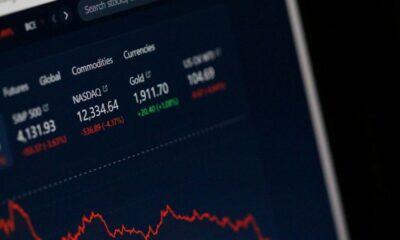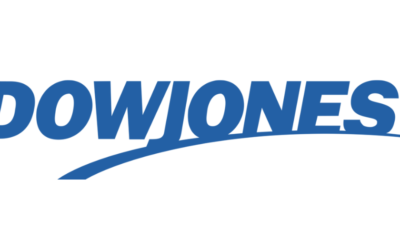Business
Best ETFs for Building a Balanced Investment Portfolio

Investing in exchange-traded funds (ETFs) can be a smart way to build a balanced investment portfolio. These funds combine different types of assets, such as stocks and bonds, to help manage risk while aiming for growth. This article highlights some of the best ETFs that cater to various investment styles, from conservative to aggressive, ensuring there’s something for everyone.
Key Takeaways
- Balanced ETFs combine stocks and bonds, offering a mix of growth and income.
- They tend to be less risky than funds that only invest in stocks.
- Investors can choose from various strategies, including conservative and aggressive options.
- Low fees are often a key advantage of many ETFs, making them cost-effective.
- Diversification helps reduce the risk of significant losses in any single investment.
1. iShares Core Aggressive Allocation ETF
The iShares Core Aggressive Allocation ETF (AOA) is designed for investors who are looking for a high-risk, high-reward investment option. This ETF primarily invests in a mix of stocks and bonds, with a significant focus on equities. Here are some key details about AOA:
| Feature | Value |
|---|---|
| Expense Ratio | 0.15% |
| Dividend Yield | 2.09% |
| 10-Year Avg. Annual Return | 7.36% |
Key Characteristics:
- Aggressive Growth: AOA aims for aggressive growth by holding approximately 80% in stocks and 20% in bonds.
- Diversified Portfolio: The fund includes a variety of iShares ETFs, covering both domestic and international markets.
- Low Fees: With an expense ratio of just 0.15%, it offers a cost-effective way to invest.
Investing in AOA can be a smart choice for younger investors who are willing to take on more risk for potentially higher returns.
In summary, the iShares Core Aggressive Allocation ETF is a solid option for those looking to build a balanced portfolio with a focus on growth. Its low fees and diversified holdings make it an attractive choice for aggressive investors.
2. iShares Core Growth Allocation ETF
The iShares Core Growth Allocation ETF (AOR) is an excellent option for investors looking for a balanced approach to growth. This fund is designed to provide a moderate level of risk while aiming for capital appreciation.
Key Features:
- Expense Ratio: 0.15%
- Dividend Yield: 2.41%
- 10-Year Average Annual Return: 5.98%
Asset Allocation:
The fund maintains a strategic allocation of approximately 60% in stocks and 40% in bonds. This mix is ideal for those who want to grow their investments without taking on excessive risk.
| Asset Class | Percentage |
|---|---|
| Stocks | 60% |
| Bonds | 40% |
Why Choose AOR?
- Diversification: AOR invests in a variety of iShares ETFs, covering both U.S. and international markets.
- Moderate Risk: The fund’s allocation strategy is suitable for investors who prefer a balanced approach.
- Low Fees: With a low expense ratio, AOR is a cost-effective choice for long-term investors.
Investing in balanced funds like AOR can help you achieve a more secure financial future by spreading risk across different asset classes.
In summary, the iShares Core Growth Allocation ETF is a solid choice for those looking to build a balanced investment portfolio with a focus on growth while managing risk effectively.
3. iShares Core Moderate Allocation ETF
The iShares Core Moderate Allocation ETF (AOM) is designed for investors who prefer a balanced approach to risk. This fund typically holds about 60% in bonds and 40% in stocks, making it a suitable choice for those who are more conservative in their investment strategy.
Key Features:
- Expense Ratio: 0.15%
- Dividend Yield: 2.76%
- 5-Year Annualised Return: 4.3%
Asset Allocation:
| Asset Class | Percentage |
|---|---|
| Bonds | 60% |
| Stocks | 40% |
Why Choose AOM?
- Diversification: The fund invests in a mix of seven iShares ETFs, providing exposure to various sectors.
- Stability: With a conservative allocation, it aims to reduce volatility, making it ideal for those nearing retirement or with a low risk tolerance.
- Income Generation: The dividend yield offers a steady income stream, which is beneficial for long-term investors.
The iShares Core Moderate Allocation ETF is a solid option for those looking to maintain a balanced portfolio while managing risk effectively.
In summary, AOM is a great choice for investors seeking a low-fee fund that can serve as a core holding in their investment strategy. Its conservative asset mix is particularly appealing for those who prefer a more cautious approach to investing.
4. Vanguard Balanced Index Fund Admiral Shares
The Vanguard Balanced Index Fund Admiral Shares (VBIAX) is a great choice for investors looking for a low-cost, balanced fund. This fund typically invests about 60% in stocks and 40% in bonds, providing a mix that aims to generate both growth and income.
Key Features:
- Low Expense Ratio: With an expense ratio of just 0.07%, this fund is one of the most cost-effective options available.
- Diversified Portfolio: By holding both stocks and bonds, it offers a diversified investment strategy that can help reduce risk.
- Solid Returns: The fund has shown an annualised return of 8.3% over the last five years.
Performance Overview:
| Metric | Value |
|---|---|
| 5-Year Annualised Return | 8.3% |
| Expense Ratio | 0.07% |
| Dividend Yield | 1.98% |
This fund is a low-cost, domestic balanced fund that provides growth while generating income at the same time.
Considerations:
- Asset Allocation Control: Investors do not control the fund’s asset allocation, which may not suit everyone’s needs.
- Market Exposure: The fund’s performance is tied to the broader U.S. stock and bond markets, which can be volatile.
- Long-Term Investment: Ideal for those looking to invest for the long term, balancing risk and return effectively.
In summary, the Vanguard Balanced Index Fund Admiral Shares is a strong option for those seeking a balanced approach to investing, combining both growth and income in a single fund.
5. Fidelity Balanced Fund
The Fidelity Balanced Fund is designed to provide both income and capital growth while managing risk effectively. This fund typically allocates about 60% of its assets to stocks and 40% to bonds, making it a solid choice for investors seeking a balanced approach.
Key Features:
- Diversification: By holding both equities and fixed income, the fund aims to reduce volatility compared to stock-only funds.
- Performance: Over the past five years, the fund has achieved an annualised return of 11.0%.
- Cost Efficiency: With an expense ratio of just 0.47%, it remains affordable for investors.
Performance Overview:
| Metric | Value |
|---|---|
| 5-Year Annualised Return | 11.0% |
| Expense Ratio | 0.47% |
| Dividend Yield | 1.56% |
The Fidelity Balanced Fund is a great option for those looking to balance growth and income in their investment portfolio. It combines the benefits of stocks and bonds, making it a versatile choice for various market conditions.
In summary, the Fidelity Balanced Fund offers a well-rounded investment strategy that can suit many investors’ needs. Its combination of stocks and bonds provides a balanced portfolio that aims to achieve both growth and income, making it a valuable addition to any investment strategy.
6. SPDR SSGA Global Allocation ETF
The SPDR SSGA Global Allocation ETF (GAL) is designed to provide a balanced investment approach by investing in a mix of assets. This ETF typically allocates around 60% of its assets to equities, while the remaining 40% is invested in bonds and other securities.
Key Features:
- 5-Year Returns (Annualised): 6.3%
- Expense Ratio: 0.35%
- Dividend Yield: 2.62%
Investment Strategy:
- Diversification: GAL invests in a variety of exchange-traded funds, ensuring a broad exposure to different markets.
- Global Reach: At least 30% of its assets are allocated to international markets, providing investors with global diversification.
- Balanced Approach: The ETF aims to balance risk and return by maintaining a mix of stocks and bonds.
This ETF is a great option for investors looking for a diverse portfolio that can adapt to changing market conditions.
In summary, the SPDR SSGA Global Allocation ETF offers a well-rounded investment strategy that can help build a balanced portfolio, making it a solid choice for both new and experienced investors.
7. WisdomTree U.S. Efficient Core Fund
The WisdomTree U.S. Efficient Core Fund (NTSX) is designed for investors looking for a balanced approach to growth and income. This fund is unique because it invests in individual large-cap stocks and U.S. Treasury futures contracts, rather than being a fund-of-funds.
Key Features
- Expense Ratio: 0.20%
- Dividend Yield: 1.11%
- Average Annual Return Since Inception (Aug. 2018): 9.96%
Asset Allocation
The fund maintains a conservative asset allocation of approximately:
| Asset Type | Percentage |
|---|---|
| Treasury Futures | 60% |
| Large-Cap Stocks | 40% |
Investment Strategy
- Focuses on capital growth and income.
- Utilises fixed income futures for lower correlation with stocks.
- Adapts asset allocation based on market conditions.
This fund is ideal for those who prefer a balanced investment strategy with a focus on stability and growth.
In summary, the WisdomTree U.S. Efficient Core Fund offers a solid option for investors seeking a blend of capital appreciation and income generation, making it a valuable addition to a balanced investment portfolio.
8. Cambria Global Asset Allocation ETF
The Cambria Global Asset Allocation ETF (GAA) is a standout choice for investors looking for a well-rounded fund. This ETF is designed to provide a broad diversification of assets, making it suitable for various investment strategies. Here are some key features:
- Expense Ratio: 0.43%
- Dividend Yield: 3.64%
- Average Annual Return Since Inception (Dec. 2014): 5.11%
Asset Allocation
The fund maintains a balanced approach with the following allocations:
| Asset Class | Allocation |
|---|---|
| Stocks | 45% |
| Bonds | 45% |
| Other Assets | 10% |
Key Benefits
- Wide Range of Investments: GAA includes both domestic and international equities, bonds, real estate, commodities, and currencies.
- Active Management: The fund is actively managed, allowing for adjustments based on market conditions.
- Tax Considerations: The fund takes taxes into account when rebalancing, which is beneficial for taxable accounts.
Investing in GAA can be a smart move for those seeking a comprehensive investment strategy that covers multiple asset classes.
In summary, the Cambria Global Asset Allocation ETF is an excellent option for investors wanting a diverse portfolio with a mix of stocks, bonds, and other assets. Its balanced approach and active management make it a strong contender in the ETF market.
9. SPDR SSGA Multi-Asset Real Return ETF
The SPDR SSGA Multi-Asset Real Return ETF aims to protect your money and create income, striving to achieve a real return that outpaces inflation. This ETF is actively managed and invests in a mix of domestic and international inflation-protected securities, real estate, and commodities. It particularly focuses on sectors like agriculture, energy, and metals, which tend to do well when inflation rises.
Key Features:
- Expense Ratio: 0.50%
- Dividend Yield: 3.32%
- 10-Year Average Annual Return: 2.91%
Portfolio Breakdown:
| Asset Class | Allocation (%) |
|---|---|
| Inflation-Protected Securities | 40% |
| Commodities | 30% |
| Real Estate | 20% |
| Cash | 10% |
Why Consider This ETF:
- Inflation Hedge: Designed to perform well during inflationary periods.
- Diversified Holdings: Invests across various sectors to reduce risk.
- Income Generation: Aims to provide steady income through dividends.
This ETF is a solid choice for those looking to safeguard their investments against inflation while still aiming for growth. It’s particularly relevant in today’s market, where the stock market experienced a significant decline due to rising yields and global concerns.
10. Pacer WealthShield ETF
The Pacer WealthShield ETF (PWS) is designed to help investors achieve a balanced portfolio through a unique strategy. This ETF focuses on investing in high-yield corporate bonds, U.S. Treasury securities, and U.S. stocks.
Key Features
- Expense Ratio: 0.60%
- Dividend Yield: 1.63%
- Average Annual Return Since Inception (Dec. 2017): 3.99%
Investment Strategy
PWS employs a rules-based approach to identify and invest in the strongest equity sectors and the highest yielding fixed income securities. This strategy aims to provide a solid return while managing risk effectively.
Performance Overview
| Metric | Value |
|---|---|
| Expense Ratio | 0.60% |
| Dividend Yield | 1.63% |
| Avg. Annual Return (Since 2017) | 3.99% |
The Pacer WealthShield ETF is a 12-time award-winning fund provider, recognised for its client-focused philosophy.
This ETF is suitable for investors looking for a balanced approach, combining both growth and income. Here are some reasons to consider PWS:
- Diversification across various asset classes.
- A focus on high-yield opportunities.
- A rules-based strategy that adapts to market conditions.
11. iShares Core Total USD Bond Market ETF
The iShares Core Total USD Bond Market ETF (IUSB) is designed to provide investors with exposure to the entire U.S. fixed income market. This ETF is a great choice for those looking to balance their portfolios with a solid bond foundation.
Key Features:
- Expense Ratio: 0.15%
- Dividend Yield: 2.41%
- Average Annual Return: 5.98% since inception
Portfolio Composition:
The ETF primarily invests in:
- Treasury bonds
- Government-agency bonds
- Investment-grade corporate bonds
This diverse mix helps to reduce risk while aiming for steady returns.
Advantages of IUSB:
- Broad Market Coverage: It includes a wide range of bonds, making it a comprehensive choice.
- Low Fees: With a low expense ratio, it’s cost-effective for long-term investors.
- Steady Income: The dividend yield provides a reliable income stream.
Investing in the iShares Core Total USD Bond Market ETF can be a smart move for those seeking stability in their investment portfolios. It offers a simple way to gain exposure to a variety of bonds, helping to balance risk and return effectively.
Overall, the iShares Core Total USD Bond Market ETF is an excellent option for investors looking to enhance their portfolios with a strong bond component, ensuring a well-rounded investment strategy.
12. iShares International Bond ETF
The iShares International Bond ETF (IAGG) is designed to provide exposure to a wide range of international bonds. This ETF primarily invests in bonds issued by governments and corporations outside the United States, making it a great option for those looking to diversify their fixed income portfolio.
Key Features
- Diversification: IAGG includes bonds from various countries, which helps reduce risk.
- Low Expense Ratio: With a competitive expense ratio, it keeps costs down for investors.
- Income Generation: The ETF aims to provide regular income through interest payments.
Performance Overview
| Metric | Value |
|---|---|
| 5-Year Annualised Returns | 4.5% |
| Expense Ratio | 0.35% |
| Dividend Yield | 2.1% |
Considerations
- Currency Risk: Investing in international bonds exposes you to fluctuations in currency values.
- Market Volatility: Like all investments, IAGG can be affected by market changes.
- Interest Rate Sensitivity: Bond prices can fall when interest rates rise.
Investing in international bonds can be a smart way to enhance your portfolio’s balance and reduce overall risk. However, it’s essential to understand the associated risks before diving in.
In summary, the iShares International Bond ETF is a solid choice for investors seeking to add international fixed income exposure to their portfolios. Its diversified approach and low costs make it an attractive option for many investors.
13. iShares Core Conservative Allocation ETF
The iShares Core Conservative Allocation ETF (AOK) is designed for investors who prefer a more cautious approach to investing. This fund typically allocates around 60% of its assets to bonds and 40% to stocks, making it suitable for those who are nearing retirement or have a low risk tolerance.
Key Features:
- Asset Allocation: 60% bonds, 40% stocks.
- Investment Strategy: Primarily invests in seven iShares ETFs, focusing on a mix of U.S. and international assets.
- Risk Level: Low, ideal for conservative investors.
Portfolio Breakdown:
| Asset Class | Percentage |
|---|---|
| U.S. Bonds | 50% |
| International Bonds | 9% |
| U.S. Stocks (S&P 500) | 20% |
| Emerging Market Stocks | 10% |
| Mid and Small-Cap Stocks | 11% |
This ETF is a great choice for those looking to maintain a balanced portfolio while minimising risk. It offers a steady income stream and potential for growth, making it a solid option for conservative investors.
Why Choose AOK?
- Diversification: By investing in multiple asset classes, it reduces risk.
- Low Expense Ratio: AOK has a competitive expense ratio, making it cost-effective.
- Steady Income: The bond-heavy allocation provides a reliable income stream.
In summary, the iShares Core Conservative Allocation ETF is an excellent option for investors seeking a low-risk, diversified investment that can help preserve capital while still offering some growth potential.
14. iShares Core 60/40 Allocation ETF
The iShares Core 60/40 Allocation ETF is designed for investors looking for a balanced approach to investing. This fund typically holds about 60% in bonds and 40% in stocks, making it a suitable choice for those who prefer a conservative investment strategy.
Key Features:
- Asset Allocation: 60% bonds and 40% stocks.
- Expense Ratio: 0.15%.
- Dividend Yield: 2.76%.
Portfolio Composition:
The ETF includes a mix of various iShares ETFs, which helps in diversifying the investment. Here’s a brief overview of its composition:
| Asset Type | Percentage |
|---|---|
| Bonds | 60% |
| Stocks | 40% |
Why Choose This ETF?
- Stability: The bond allocation provides a cushion against market volatility.
- Growth Potential: The stock portion allows for capital appreciation.
- Low Fees: With an expense ratio of just 0.15%, it’s cost-effective.
This ETF is ideal for those who want to minimise longevity risk while still aiming for growth in their investment portfolio. It’s particularly suitable for retirees or conservative investors who prefer a steady income stream.
In summary, the iShares Core 60/40 Allocation ETF offers a balanced investment strategy that combines the safety of bonds with the growth potential of stocks, making it a solid choice for a diversified portfolio.
15. Invesco Balanced-Risk Commodity Strategy ETF

The Invesco Balanced-Risk Commodity Strategy ETF is designed to provide a balanced approach to investing in commodities. This ETF aims to reduce risk while still offering potential growth opportunities.
Key Features:
- Diversification: This ETF invests in a variety of commodities, which helps spread risk across different sectors.
- Risk Management: It employs strategies to manage risk effectively, making it suitable for cautious investors.
- Performance Tracking: The ETF aims to track the performance of a balanced-risk commodity strategy, which can be beneficial in volatile markets.
Performance Overview:
| Metric | Value |
|---|---|
| 5-Year Annualised Return | 8.5% |
| Expense Ratio | 0.25% |
| Dividend Yield | 1.75% |
Investing in balanced-risk strategies can help investors achieve a more stable return over time, especially in uncertain market conditions.
In summary, the Invesco Balanced-Risk Commodity Strategy ETF is a solid choice for those looking to include commodities in their portfolio while managing risk effectively. It offers a balanced approach that can complement other investments in a diversified portfolio.
16. First Trust Multi-Asset Diversified Income ETF
The First Trust Multi-Asset Diversified Income ETF (MDIV) is designed to provide a steady income stream through a mix of various asset classes. This ETF aims to achieve a balanced approach by investing in both equities and fixed income, making it suitable for investors looking for diversification.
Key Features:
- Expense Ratio: 0.70%
- Dividend Yield: 4.50%
- Average Annual Return: 5.00% since inception
Asset Allocation:
| Asset Class | Percentage Allocation |
|---|---|
| Equities | 50% |
| Bonds | 30% |
| Real Estate | 10% |
| Commodities | 5% |
| Cash | 5% |
Benefits of MDIV:
- Diversification: By investing in multiple asset classes, MDIV reduces risk.
- Income Generation: The ETF focuses on providing a consistent income through dividends.
- Inflation Hedge: The inclusion of commodities can help protect against inflation.
The First Trust Multi-Asset Diversified Income ETF is a solid choice for those seeking a blend of growth and income, making it a valuable addition to a balanced portfolio.
17. JPMorgan Equity Premium Income ETF
The JPMorgan Equity Premium Income ETF (JEPI) is designed for investors looking for a blend of income and growth. This ETF focuses on generating income through dividends while also aiming for capital appreciation.
Key Features:
- Expense Ratio: 0.35%
- Dividend Yield: 2.41%
- 10-Year Avg. Annual Return: 5.98%
Performance Overview:
| Metric | Value |
|---|---|
| Expense Ratio | 0.35% |
| Dividend Yield | 2.41% |
| 10-Year Avg. Ann. Return | 5.98% |
Investment Strategy:
- Equity Selection: Focuses on high-quality stocks with strong dividend yields.
- Options Strategy: Utilises options to enhance income and reduce volatility.
- Diversification: Invests across various sectors to mitigate risks.
The JPMorgan Equity Premium Income ETF has an asset-weighted carbon risk score of 6.9, indicating that its companies have low exposure to carbon-related risks. This makes it a suitable choice for environmentally conscious investors.
18. Global X SuperDividend ETF
The Global X SuperDividend ETF is designed for investors looking for high dividend yields. This ETF focuses on companies that pay out high dividends, making it an attractive option for income-seeking investors. Here are some key details:
Key Features:
- 5-year returns (annualised): 11.0 percent
- Expense ratio: 0.47 percent
- Dividend yield: 1.56 percent
Why Consider This ETF?
- High Dividend Focus: It targets companies with strong dividend payouts.
- Diversification: The ETF includes a variety of sectors, reducing risk.
- Income Generation: Ideal for those looking to supplement their income.
Investing in high-dividend ETFs like the Global X SuperDividend ETF can provide a steady income stream, especially in uncertain market conditions.
This ETF is a solid choice for those wanting to balance their portfolio with income-generating assets while still having exposure to equity markets.
19. Invesco S&P 500 Equal Weight ETF

The Invesco S&P 500 Equal Weight ETF (RSP) offers a unique approach to investing in the S&P 500 by giving equal weight to all its constituents. This means that each company, regardless of its size, has the same impact on the fund’s performance. This strategy can lead to better diversification and potentially higher returns compared to traditional market-cap weighted ETFs.
Key Features:
- Expense Ratio: 0.40%
- Dividend Yield: 1.80%
- 10-Year Avg. Annual Return: 10.50%
Benefits of Investing in RSP:
- Diversification: Reduces the risk associated with large-cap stocks dominating the portfolio.
- Potential for Higher Returns: Equal weighting can lead to better performance during market recoveries.
- Simplicity: Easy to understand and manage as a core holding in a balanced portfolio.
Investing in the Invesco S&P 500 Equal Weight ETF can be a smart choice for those looking to balance their portfolios with a focus on trustworthy resources and diversified exposure to the U.S. market.
20. Schwab U.S. Broad Market ETF
The Schwab U.S. Broad Market ETF is a great choice for investors looking to gain exposure to the entire U.S. stock market. This ETF includes a wide range of companies, from large to small, making it a solid option for diversification.
Key Features:
- Diverse Holdings: The ETF covers thousands of stocks, providing a broad representation of the U.S. economy.
- Low Costs: Schwab is known for its low expense ratios, which means more of your money stays invested.
- Liquidity: This ETF is highly liquid, making it easy to buy and sell shares without significant price changes.
Performance Overview:
| Year | Return (%) |
|---|---|
| 2020 | 18.4 |
| 2021 | 22.0 |
| 2022 | -5.0 |
Investing in a broad market ETF like Schwab’s can help you weather market ups and downs, as it spreads your risk across many sectors.
Considerations:
- Market Volatility: While broad market ETFs can reduce risk, they are still subject to market fluctuations.
- Long-Term Investment: This ETF is best suited for long-term investors who can ride out short-term market changes.
- Rebalancing: Regularly check your portfolio to ensure it aligns with your investment goals.
In summary, the Schwab U.S. Broad Market ETF is an excellent option for those seeking a balanced and diversified investment in the U.S. stock market, especially in times when the stock market faces significant declines due to factors like rising treasury yields.
21. iShares Russell 2000 ETF
The iShares Russell 2000 ETF is a popular choice for investors looking to gain exposure to small-cap U.S. stocks. This ETF tracks the performance of the Russell 2000 Index, which includes 2,000 of the smallest publicly traded companies in the U.S. market. Here are some key points about this ETF:
- Diversification: Investing in small-cap stocks can provide diversification benefits, as these companies often behave differently than larger firms.
- Growth Potential: Small-cap stocks have the potential for higher growth compared to their larger counterparts, making this ETF appealing for growth-oriented investors.
- Expense Ratio: The iShares Russell 2000 ETF has a low expense ratio, making it a cost-effective option for investors.
Key Statistics
| Metric | Value |
|---|---|
| 5-Year Annualised Return | 11.0% |
| Expense Ratio | 0.47% |
| Dividend Yield | 1.56% |
Investing in small-cap stocks can be a great way to tap into the growth potential of emerging companies. However, it’s important to consider the risks involved, as these stocks can be more volatile than larger companies.
Overall, the iShares Russell 2000 ETF is a solid choice for those looking to add small-cap exposure to their investment portfolio, balancing potential growth with the benefits of diversification.
22. SPDR S&P 500 ETF Trust
The SPDR S&P 500 ETF Trust is a popular choice for investors looking to gain exposure to the U.S. stock market. This ETF aims to track the performance of the S&P 500 index, which includes a mix of large-cap companies. By investing in this ETF, you can benefit from both growth and value stocks.
Key Features:
- 5-Year Returns (Annualised): 11.0%
- Expense Ratio: 0.47%
- Dividend Yield: 1.56%
| Feature | Value |
|---|---|
| 5-Year Returns | 11.0% |
| Expense Ratio | 0.47% |
| Dividend Yield | 1.56% |
Why Choose SPDR S&P 500 ETF Trust?
- Diversification: It holds a wide range of stocks, reducing risk.
- Low Costs: With a reasonable expense ratio, it’s cost-effective.
- Liquidity: This ETF is traded like a stock, making it easy to buy and sell.
Investing in the SPDR S&P 500 ETF Trust can be a smart way to build a balanced portfolio, as it provides exposure to the overall market performance while keeping costs low.
23. iShares MSCI ACWI ETF
The iShares MSCI ACWI ETF is a popular choice for investors looking to gain exposure to a wide range of global stocks. This ETF tracks the performance of the MSCI All Country World Index, which includes both developed and emerging markets. Here are some key features:
- 5-Year Returns (Annualised): 11.0%
- Expense Ratio: 0.47%
- Dividend Yield: 1.56%
Key Benefits
- Global Diversification: This ETF provides access to thousands of stocks from various countries, helping to spread risk.
- Low Cost: With an expense ratio of just 0.47%, it’s a cost-effective way to invest in global equities.
- Strong Historical Performance: The annualised returns over the past five years have been impressive, making it an attractive option for long-term investors.
Investing in the iShares MSCI ACWI ETF can be a smart move for those seeking a balanced portfolio with international exposure.
Considerations
- Market Fluctuations: As with any equity investment, the value can fluctuate based on market conditions.
- Currency Risk: Investing in international stocks exposes you to currency risk, which can affect returns.
- Sector Exposure: The ETF may have significant exposure to certain sectors, which could impact performance depending on market trends.
Overall, the iShares MSCI ACWI ETF is a solid choice for investors looking to build a diversified portfolio with a global reach. It’s particularly suitable for those who prefer a passive investment strategy while still wanting to capture growth from various markets.
24. iShares U.S. Treasury Bond ETF
The iShares U.S. Treasury Bond ETF is a popular choice for investors looking for stability and safety in their portfolios. This ETF primarily invests in U.S. Treasury bonds, which are backed by the government, making them a low-risk option.
Key Features:
- Cost Efficiency: The ETF has excellent costs, making it a budget-friendly option for investors.
- Tracking Error: It boasts an excellent tracking error, ensuring that it closely follows the performance of its benchmark.
- Bid/Ask Ratio: The bid/ask ratio is good, which means investors can buy and sell shares without significant price differences.
- Holdings Diversity: The ETF offers good diversity in its holdings, providing exposure to various maturities of Treasury bonds.
Advantages of Investing:
- Safety: U.S. Treasury bonds are considered one of the safest investments available.
- Liquidity: The ETF can be easily bought and sold on the stock market, providing flexibility.
- Income Generation: Investors receive regular interest payments, which can be a reliable source of income.
Investing in the iShares U.S. Treasury Bond ETF can be a smart move for those seeking a stable and secure investment option. It combines low risk with the potential for steady returns, making it suitable for conservative investors.
25. iShares TIPS Bond ETF and more
Overview of iShares TIPS Bond ETF
The iShares TIPS Bond ETF is a great choice for those looking for inflation-protected bonds. It invests in Treasury Inflation-Protected Securities (TIPS), which adjust their principal value based on inflation rates. This means that as inflation rises, so does the value of your investment.
Key Features
- Inflation Protection: TIPS are designed to protect against inflation, making them a solid choice during economic uncertainty.
- Government Backing: These securities are backed by the U.S. government, providing a level of security for investors.
- Diversification: Including TIPS in your portfolio can help balance out risks associated with other investments.
Comparison with Other ETFs
Here’s a quick comparison of some popular TIPS ETFs:
| ETF Name | Expense Ratio | Dividend Yield | Average Annual Return |
|---|---|---|---|
| iShares TIPS Bond ETF (TIP) | 0.19% | 1.25% | 3.50% |
| SPDR® Portfolio TIPS ETF (SPIP) | 0.12% | 1.20% | 3.45% |
| Schwab U.S. TIPS ETF (SCHP) | 0.05% | 1.30% | 3.60% |
Considerations
- Market Risks: Like all investments, TIPS can be affected by market volatility. Prices may fluctuate, and returns are not guaranteed.
- Interest Rate Sensitivity: TIPS may lose value during periods of rising interest rates, which can impact overall returns.
- Management Fees: Be aware of the fees associated with each ETF, as they can affect your overall returns.
Investing in TIPS can be a smart strategy for those looking to safeguard their investments against inflation while still earning a return.
In summary, the iShares TIPS Bond ETF and similar funds can be valuable additions to a balanced investment portfolio, especially for those concerned about inflation.
Frequently Asked Questions
What is a balanced ETF?
A balanced ETF combines different types of investments, usually stocks and bonds, to help reduce risk. It aims to provide both growth and income.
How do balanced ETFs work?
Balanced ETFs invest in a mix of assets. For example, they might hold 60% stocks and 40% bonds, giving you a diverse portfolio.
Are balanced ETFs suitable for all investors?
Balanced ETFs can be good for many investors, but they may not fit everyone. If you prefer to control your own investments, you might want to look elsewhere.
What are the advantages of investing in balanced ETFs?
They offer a simple way to diversify your investments, typically have lower fees, and can reduce the risk compared to investing in stocks alone.
Can I lose money with balanced ETFs?
Yes, like any investment, balanced ETFs can lose value, especially if the stock market drops. It’s important to understand the risks.
How do I choose the right balanced ETF?
Look for factors like fees, the mix of assets, and past performance. Consider your own risk tolerance and investment goals.
What’s the difference between ETFs and mutual funds?
ETFs trade like stocks on an exchange throughout the day, while mutual funds are bought and sold at the end of the trading day.
How can I start investing in balanced ETFs?
You can start by opening an investment account with a broker and then buying shares of the ETFs you’re interested in.
-

 Press Release6 days ago
Press Release6 days agoBellarium ($BEL) Price Prediction: Could It Hit $5 by 2026?
-

 Press Release3 days ago
Press Release3 days agoClinical Trials Market Set for Robust Growth, Driven by Drug Development Surge and Digital Innovation
-

 Business5 days ago
Business5 days agoHow Managed IT Solutions Help Small Teams Compete at Enterprise Scale
-

 Press Release4 days ago
Press Release4 days agoFill-Finish Pharmaceutical Contract Manufacturing Market Expected to Flourish Amid Biopharmaceutical Boom and Global Outsourcing Trend by 2035
-

 Press Release4 days ago
Press Release4 days agoIndustrial Boiler Market Expected to Surpass USD 24.4 Billion by 2035 Amid Growing Demand for Energy Efficiency and Industrialization
-

 Press Release4 days ago
Press Release4 days agoPreventive Vaccines Market to Witness Strong Growth by 2035
-

 Press Release4 days ago
Press Release4 days agoGreen Bio Chemicals Market Poised for Sustainable Growth amidst Global Shift to Eco-Friendly Alternatives by 2035
-

 Press Release4 days ago
Press Release4 days agoPet Food Nutraceutical Market Set for Robust Expansion Amid Rising Demand for Pet Wellness by 2035




























